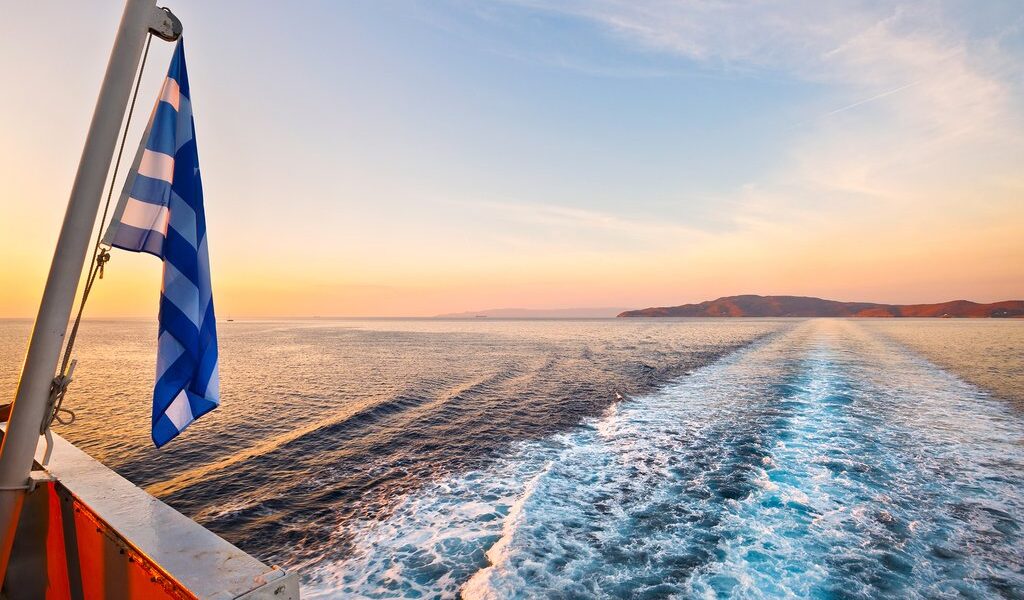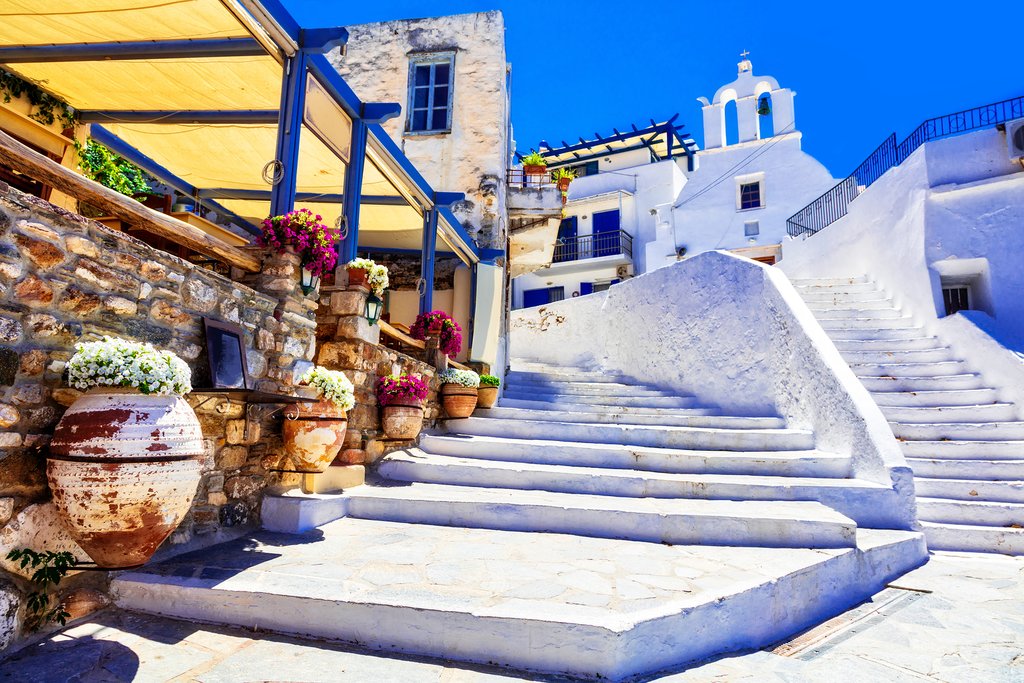
Naxos is unfairly overlooked by many visitors to the Aegean. It’s the largest and most fertile of the Cyclades Islands, and perhaps also its most quintessential, blessed with an abundance of attractions from archaeological treasures to some of the best stretches of white sand beach in Greece. From the main city of Chora to road trip-worthy villages and the glittering southwest coastline, let this guide be your essential handbook for Naxos travel.
## Discover the Enchanting Island of Naxos: A Comprehensive Guide
Naxos, often considered the hidden gem of the Cyclades islands, awaits your discovery. This island, sometimes overlooked in favor of its more flamboyant neighbors, is a true Cinderella story of the Greek Isles. In ancient times, Naxos was known as Dionysia, a name bestowed upon it for its fertile lands abundant with green orchards and bountiful vineyards. According to Greek mythology, the hard-drinking god Dionysius himself chose Naxos as his residence, a testament to the island’s captivating allure and abundant resources. Situated at the very heart of the Aegean Sea, Naxos remains largely unexplored, its interior a tapestry of verdant groves and tranquil glens, a treasure trove of natural beauty waiting to be unearthed.
Beyond its historical significance and lush landscapes, Naxos boasts a multitude of charms that captivate every visitor. Here, you will find ancient ruins whispering tales of bygone eras, charming hilltop villages steeped in tradition, and inviting waterfront cafés serving delectable local delicacies that tantalize the taste buds. Dozens of crescent-shaped beaches beckon with their soft sands and calm turquoise waters, offering a serene escape from the everyday. For travelers seeking a touch of adventure, Naxos provides ample opportunities to indulge in exhilarating kite-surfing experiences or embark on invigorating hikes into the island’s majestic mountains. Our team of expert travel specialists is dedicated to helping you craft the tailor-made trip of your dreams, ensuring an unforgettable journey filled with cherished memories.
## Navigating Your Way: Getting There & Around Naxos
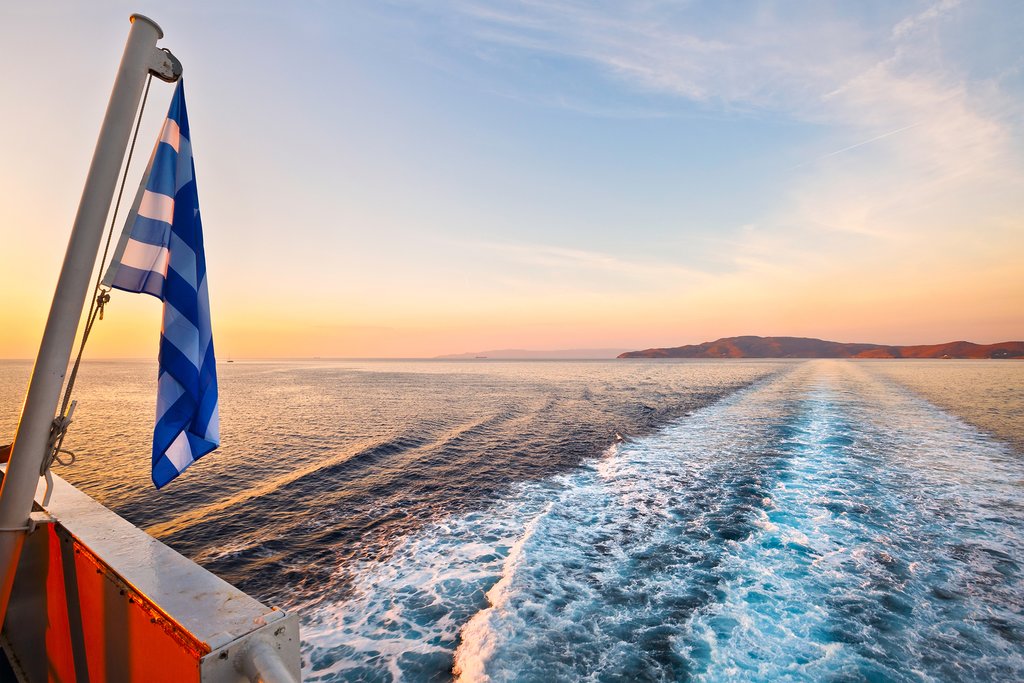
Reaching the island of Naxos is a relatively straightforward process, with several ferry companies offering regular services from Piraeus, the main port of Athens. Naxos shares a ferry route with the ever-popular island of Santorini, making it easily accessible for travelers exploring the Cyclades. During the peak tourist season, ferries depart between two and six times daily, with up to forty departures weekly during the height of summer. Given the popularity of these routes, especially during peak months and around Easter, it is highly recommended to book your ferry tickets well in advance to secure your passage.
You have a choice of ferry options to suit your preferences and schedule. The standard Blue Star ferries offer a more leisurely journey, taking approximately five to six hours to reach Naxos. For those seeking a quicker transit, faster catamarans operated by Hellenic Seaways and SeaJets can whisk you to Naxos in just three to four hours. In addition, the Skopelitis Express provides vital connections between Naxos and other neighboring Cyclades islands, allowing for convenient island hopping.
Perhaps you might be interested in extending your Cycladic adventure with a visit to the enchanting island of Paros?
Once you arrive on Naxos, navigating the island is remarkably simple. Frequent and reliable bus services connect Chora, the island’s main city, to various towns and villages scattered around the island. This provides a convenient and affordable means of exploring the main attractions and experiencing the local culture. For travelers seeking a more adventurous exploration of the less inhabited east coast, renting a scooter or car offers the freedom to discover hidden gems and secluded beaches at your own pace.
## Exploring Chora: The Heart of Naxos
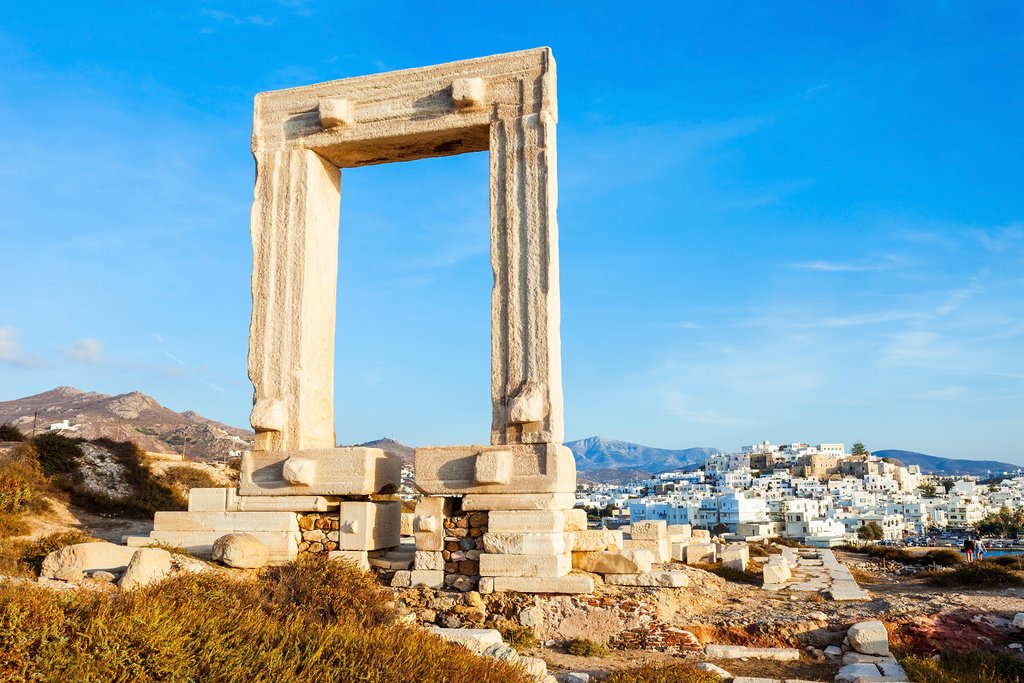
Chora, the captivating main city of Naxos, often referred to as “Naxos Town” or simply “Hora,” offers a truly memorable first impression. While it may lack the iconic voluptuous cupolas of Santorini or the picturesque windmills of Mykonos, Chora’s handsome waterfront is lined with welcoming bars and cafés, exuding a relaxed and inviting atmosphere. As you approach the harbor, your gaze will be drawn to the Portara, a colossal square marble gate that dominates a tiny island called Palatia. This island is connected to Chora’s harborfront by a charming cobbled isthmus, adding to the city’s unique character. The great portal stands as a majestic reminder of the unfinished Temple of Apollo, a grand project initiated in 522 BCE but never completed.
Venture inland from the harbor, and you’ll discover a labyrinth of narrow, cobbled alleys that wind their way between buildings showcasing a captivating blend of Byzantine, Venetian, and Cycladic architectural styles. This intricate urban landscape reflects Chora’s historical significance as a cultural center dating back to the 8th century BCE. During that era, Chora held a dominant position in commerce throughout the Cyclades, earning its reputation as the richest island in the region, thanks in no small part to its renowned wines.
### Unveiling Kastro: A Historic Labyrinth
Rising majestically above Chora’s bustling harborfront, Kastro is a captivating historic quarter characterized by its labyrinthine layout. This district’s origins trace back to the early 13th century, a testament to its rich and enduring history. Today, meticulously restored cubist mansions lead upwards towards the well-preserved Castle of Sanoudos, a prominent landmark featuring the distinctive circular Krispi Tower, which now houses a fascinating Byzantine Museum. The Della Rocca family, prominent residents of Kastro, often hosts captivating Bazoukia and orchestral concerts in the courtyard of their historic home, adding to the area’s vibrant cultural scene. Be sure to consult the local calendar for upcoming events.
Perched atop Kastro, the Archaeological Museum of Naxos awaits discovery. This impressive museum is housed within the former Palace of Sanudo, a structure built in 1627 that incorporates two of the palace’s original towers. The museum’s five-story structure showcases a remarkable collection of archaeological finds spanning back to Neolithic times. Among the highlights are its impressive collection of early marble figurines, exquisite Mycenaean vases, and delicate Roman glassware, offering a glimpse into the island’s rich and varied past.
While Kastro was originally inhabited by Venetian nobles, the Greek population resided below and to the north, in the medieval Bourgos district. This area is characterized by a warren of narrow streets adorned with vibrant bougainvillea and colorful geraniums, interspersed with numerous charming chapels. A must-see attraction in Bourgos is the 18th-century Mitropoli Zoodochou Pigis Orthodox cathedral, a significant religious landmark.
## Exploring Ancient Sites: Echoes of the Past
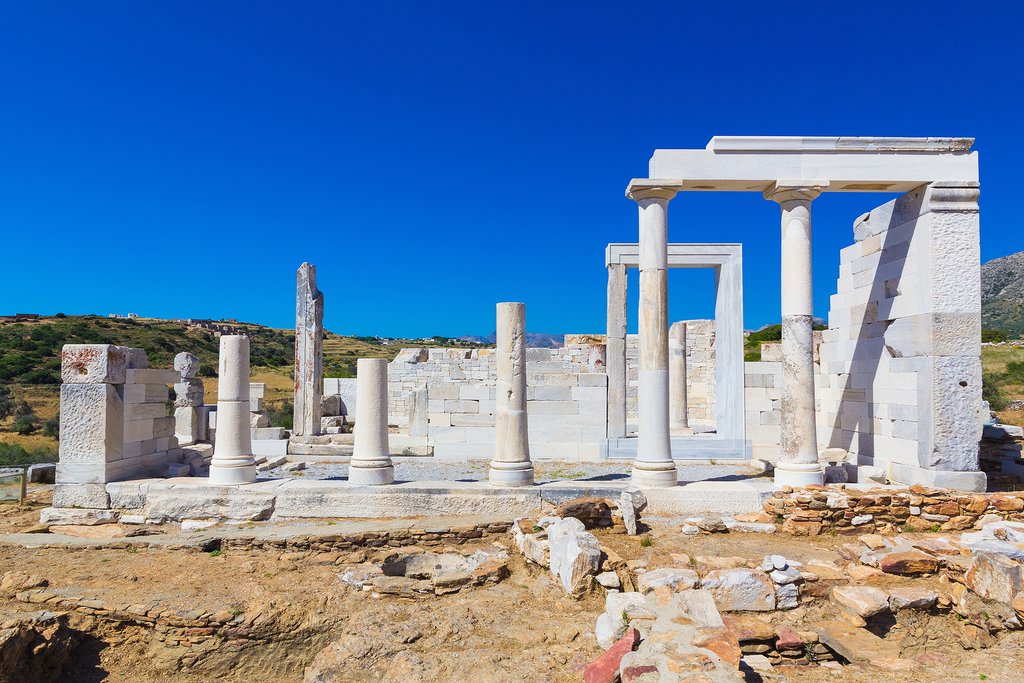
Naxos is a treasure trove of ancient sites, each offering a fascinating glimpse into the island’s rich history and mythological heritage.
### The Temple of Dionysus: Honoring the God of Wine
Located in Iria, a mere two miles south of Chora, lies the Temple of Dionysus. This magnificent temple, constructed from marble in the 6th century BCE, was dedicated to Dionysus, the revered god of wine and celebration. Once the most significant temple on the island, only its foundations and the stubs of its former columns remain today. However, a small museum on-site showcases archaeological finds discovered at the temple, including a statue of Dionysus himself.
### The Temple of Demeter: A Tribute to Agriculture
Perched atop a hill surrounded by fertile farmland, six miles southeast of Chora, stands the iconic Temple of Demeter. This 6th-century BCE temple was dedicated to Demeter, the goddess of agriculture and fertility. The ruin that visitors behold today is a partial reconstruction, completed in 1977, of the original temple, which was tragically destroyed by Christians in the 6th century CE. The Temple of Demeter is particularly stunning when viewed at sunset, as the setting sun bathes the ancient stones in a warm, golden light.
### Discovering the Kouros: Melanes & Flerio
Venture into the hills due east of Chora, and you will eventually encounter marble quarries that once supplied the raw materials for Naxos’ grand ancient temples. Approximately half-a-mile east of the charming village of Melanes, and two miles before reaching the quarries, you’ll find signs directing you to Kouros Flerio and Kouros Melanes. These two remarkable marble statues, known as kouroi, date back 2,500 years. Each stands at an impressive 16 feet in length and lies approximately 400 yards apart. Informative interpretive signs, including a map of the trail, are available in the parking lot.
### The Colossal Kouros of Apollonas
Located near the seaside village of Apollonas, in northeast Naxos, lies the Kouros of Apollonas. This unfinished gray marble statue, measuring over 30 feet long and weighing more than 80 tons, rests on the ground, resembling a petrified tree. Carved in the 8th century CE, it is believed to have been intended to represent Dionysus. However, the statue appears to have been abandoned at the quarry due to a significant fault in the marble. A roadside sign outside the village directs visitors to this impressive historical artifact.
## Sun, Sand, and Sea: Exploring Naxos’ Beaches
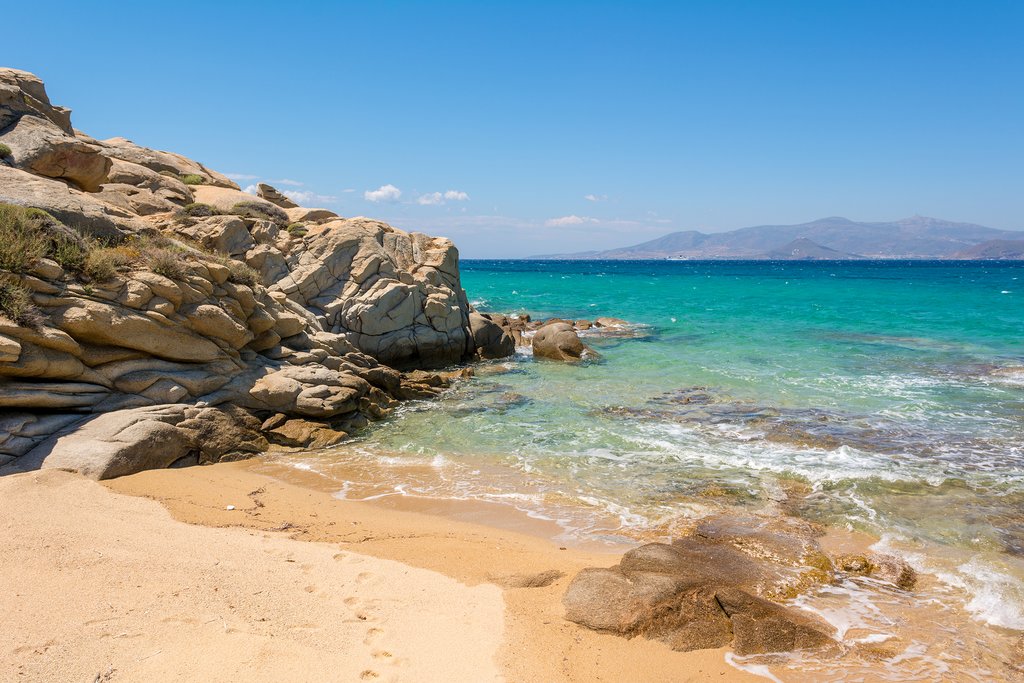
Naxos is blessed with an abundance of beautiful white-sand beaches, primarily concentrated along the western shore south of Chora. These beaches are easily accessible by bus, car, or scooter, making them popular destinations for visitors. The majority of tourists tend to frequent these well-equipped beaches, which offer a range of amenities, including watersports facilities (even scuba diving), lively bars, and traditional tavernas. However, for those with a spirit of adventure, more secluded beaches await discovery in the hidden coves along the eastern shore. These remote beaches tend to be pebbly and require some hiking to reach, so it is essential to be self-sufficient when exploring them.
Here is a selection of notable beaches, listed in order from south of Chora:
### Agios Georgios: A Convenient Escape
This crescent-shaped beach is conveniently located just a 15-minute walk from downtown Chora, making it a popular choice for visitors. As the closest beach to the city, it often experiences spillover from the bars and restaurants in Chora. The northern section of Agios Georgios offers sheltered waters, while the more exposed southern half is subject to strong Meltemi winds, resulting in noticeable waves. Beyond the headland to the south lies an area ideal for kiteboarding and windsurfing enthusiasts.
### Agios Prokopios: A Coastal Paradise
Located two miles west of Chora, Agios Prokopios is widely regarded as one of the most beautiful beaches on Naxos. Its soft, cream-colored sands stretch along half a mile of shoreline, backed by picturesque sand dunes and serene pink lagoons. Sheltered from the prevailing breezes, Agios Prokopios offers calm waters and a relaxing atmosphere. Plenty of facilities are available near the south end of the beach, providing added convenience for visitors.
### Agia Anna: Lively and Vibrant
Situated immediately south of Agios Prokopios, Agia Anna is a narrow beach brimming with lounge chairs, umbrellas, and tavernas. Due to its popularity, it can become quite crowded, especially during the high season.
### Plaka: A Haven of Tranquility
For those seeking more breathing space, Plaka is an excellent option. Located six miles south of Chora, this beach offers a more tranquil atmosphere. Although narrow, its creamy sands extend south for almost two miles. Plaka is also a favorite destination for nudists, who tend to gravitate towards the more remote southern end of the beach. Most services, including simple tavernas made of driftwood, are located at the northern end.
### Orkos: A Windsurfer’s Paradise
Tucked into a sheltered cove south of Plaka, Orkos faces into the wind, making it a top destination for kiteboarding and windsurfing. The summer months offer the perfect combination of strong winds and warm waters, while wetsuits are recommended during the spring and autumn. Early afternoon is typically the prime time to hit the waves at Orkos.
### Mikri Vigla: A Solitary Retreat
For those seeking complete solitude, Mikri Vigla, located 10 miles from Chora, is the perfect beach. Here, you can enjoy the pristine golden sands and turquoise waters in peace and tranquility. Aside from a couple of kite-surfing centers and a scattering of villas, you’ll find yourself surrounded by the unspoiled beauty of Mother Nature.
## Discovering the Villages of Naxos: A Journey into Tradition
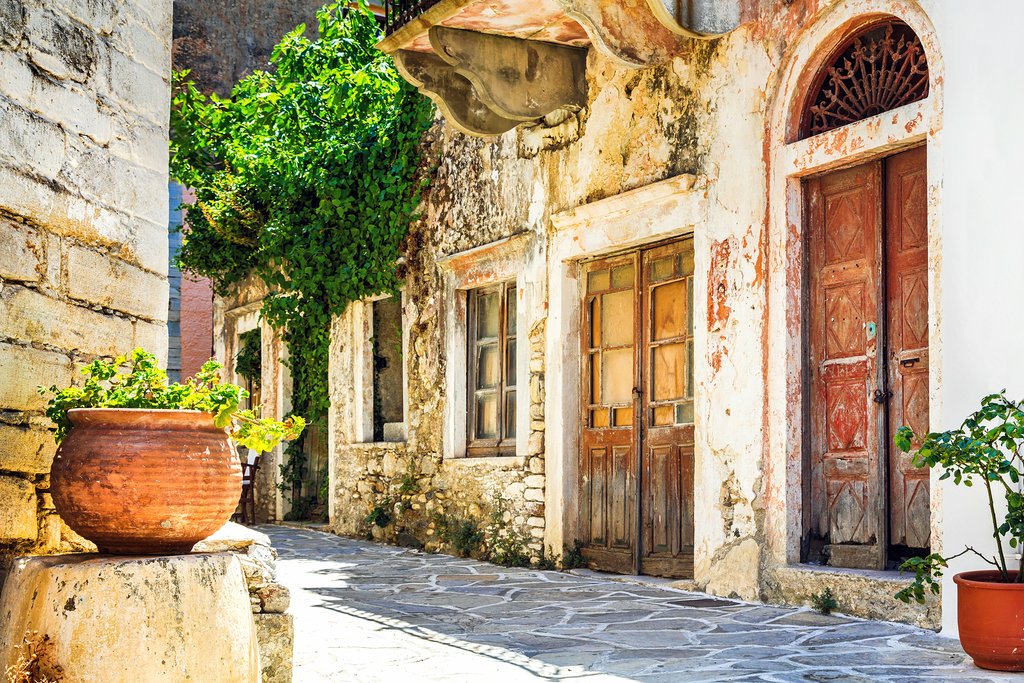
Embark on a scenic drive around Naxos and you’ll be richly rewarded with stunning views and cultural discoveries. Rent a car or scooter and venture along the narrow roads that lead out of Chora and into the tranquil interior of the island. Here are some of the highlights among Naxos’ many charming villages:
### Chalki: A Picturesque Gem
Chalki is a postcard-perfect village surrounded by lush olive and citrus groves, exuding an authentic Greek island charm. The village boasts several Venetian towers and Byzantine churches, testaments to its rich history. For centuries, the leaves of the citron tree have been used in Chalki to produce kitron naxou, a distinctive liqueur crafted by Vallindras Distillera, a distillery located on Chalki’s tiny plaza. The distillery offers guided tours and features a small museum, providing insights into the liqueur-making process. For those interested in religious architecture, the 7th-century Byzantine Panagia Drosiani, located two miles north of Chalki, is a revered church renowned for its exquisite frescoes.
### Koronos: A Cubist Masterpiece
Nestled on the hillsides of a valley and crowned with a blue-domed church, Koronos, located in the mountainous north of Naxos, is a cubist’s delight. Comprising scores of flat-roofed homes, the village offers sensational views over the vineyards that produce its renowned wines.
### Komiaki: The Highest Village
Komiaki, the highest village in Naxos, is reached via a tortuous mountain road, essentially a series of hairpin bends, heading north from Koronos. The village serves as a good base for hiking excursions into the surrounding mountains.
### Apeiranthos: A Marble Marvel
With its marble alleys gleaming white in the mountain sun, Apeiranthos, located approximately 15 miles east of Chora, is an Instagram-ready village. Here, you can expect to see older locals still dressed in traditional attire as they weave looms and lead donkeys down the cobbled streets. While the ambiance is undeniably pleasant, most visitors come to Apeiranthos to visit the Geological Museum, which displays a fascinating collection of fossils, meteorites, and local dark emery marble.
## Hiking Naxos: Conquering the Peaks
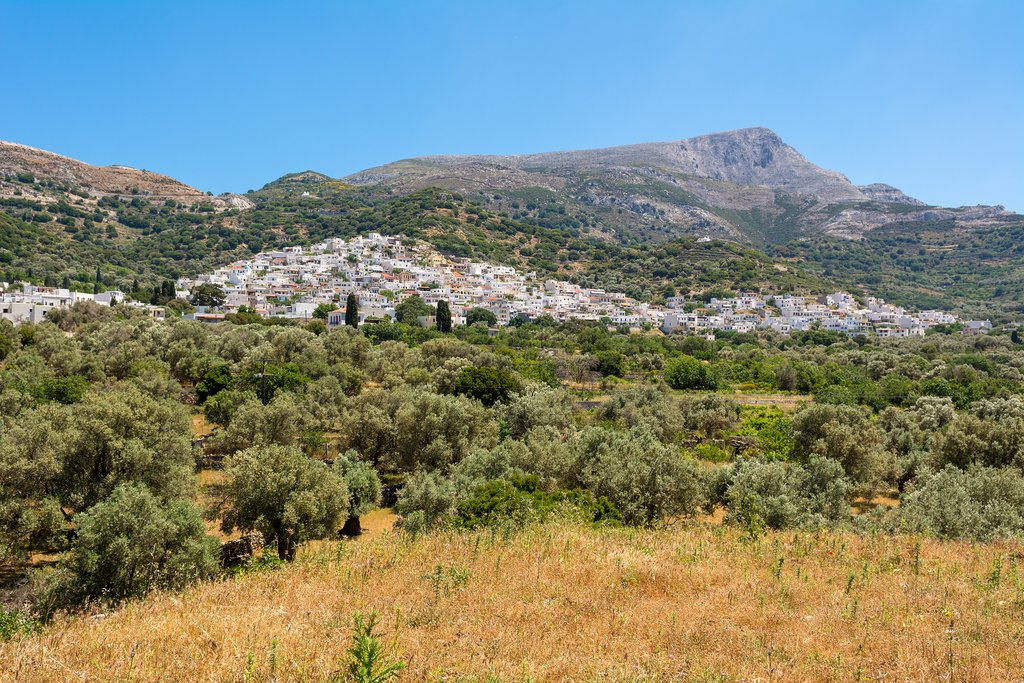
The mountainous terrain of Naxos offers tremendous hiking opportunities, with a network of well-defined trails crisscrossing the island. The Apollonas region, located in the northeast, boasts particularly impressive scenery. For those who are physically fit and adventurous, a challenging hike awaits on the steep, rocky trail from the village of Filoti to the summit of Mount Zeus (also known as Mt. Zas). Standing at 3,290 feet, Mount Zeus is the highest peak in the Cyclades. According to ancient Greek mythology, Zeus, the king of the gods, was born in a cave on the northwest flank of the mountain.
The route to the Arias Springs/Cave of Zas trail is clearly signed roadside approximately 400 yards south of Filoti. This trail, which is four miles round-trip, is steep and fairly challenging. A slightly easier option is to forego the cave visit and take the less steep but longer (five miles roundtrip) Aghia Marina trail. This trail begins at the tiny eponymous chapel. To reach the chapel, take the road from Filoti to Apiranthos and after two miles turn right at the sign for Danakos; the chapel is half-a-mile along this hairpin road. Filoti is an excellent place to grab a bite to eat before setting out on your chosen trail.
## Naxos by Night: An Evening of Entertainment
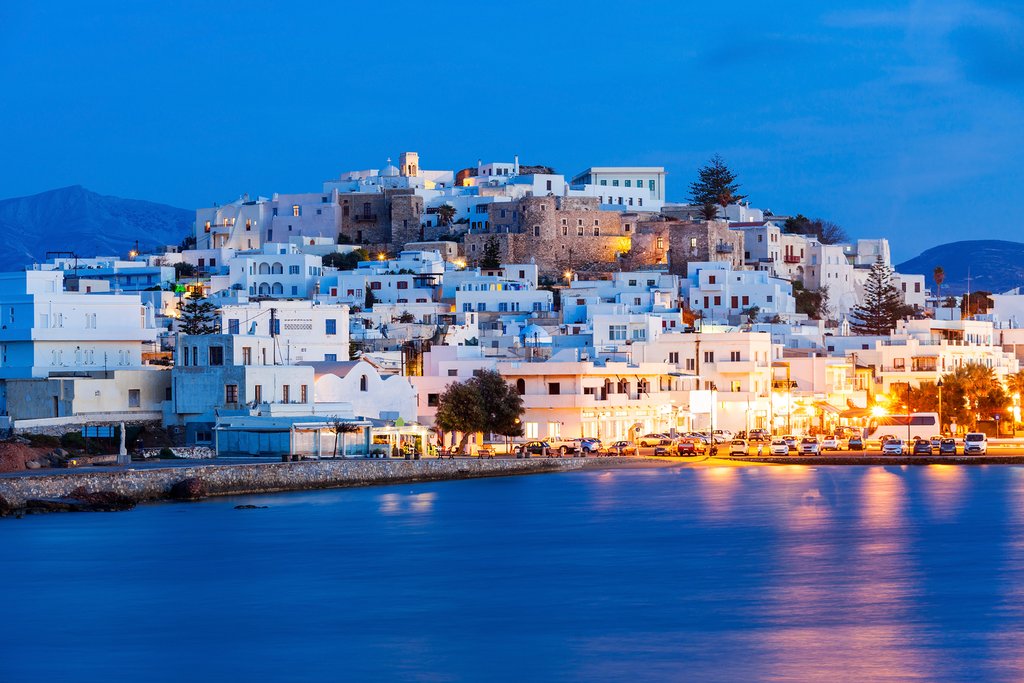
As the sun sets, Chora transforms into a vibrant hub of nightlife, offering a variety of entertainment options to suit every taste. You’ll find a selection of cool cafés, hip lounge bars, and lively nightclubs (although it’s worth noting that many of these establishments operate only during the summer months).
For a mellow evening of blues music to complement Naxos’ tranquil atmosphere, visit Jazz and Blues Bar, located at the base of Kastro. This bar attracts a mature crowd and offers comfortable outdoor seating. A younger party crowd tends to gravitate towards Prime Bar, which seamlessly transitions from a morning beachfront café to a buzzing nighttime cocktail bar. For a drink with a view, head to the rooftop terrace of the Miami-style Like Home Bar. It serves quality mojitos and offers a romantic setting beneath the stars.
Film enthusiasts can head to Cine Naxos, located on Papandreou Street at the south edge of town. During the months of May to September, Cine Naxos screens movies alfresco, providing a unique cinematic experience under the stars.
## Where to Stay: Comfortable Accommodation
Naxos offers a wide range of lodging options, from cozy guesthouses to luxurious beach resorts, ensuring that every traveler can find the perfect accommodation to suit their needs and preferences. The most atmospheric places to stay are located in or near the historic Kastro district.
Here you’ll find Hotel Grotta, a small, family-run property with a stylish all-white décor. Guests can enjoy the hotel’s jacuzzi, rooftop terrace, and delicious buffet breakfasts. For a truly historic ambiance, consider staying at Castro Residence, a two-story Venetian mansion whose tasteful furnishings include antique brass beds. The owners also operate nearby Chateau Zevgoli, an adorable six-room example of Cycladic architecture.
Outside of town, the Kouros Art Hotel is a winner, nestled beneath a cliff just a five-minute walk from Agios Prokopios beach. With just 18 rooms, it offers an intimate atmosphere and features a stunning rooftop swimming pool. For those seeking a luxurious experience, the Nissaka Beach Hotel, located on the beachfront at the north end of Agios Georgios beach and a 10-minute waterfront stroll to Kastro, is an excellent choice. With its minimalist furnishings and night-lit rooftop pool, this sleek hotel is the perfect place to relax and unwind before heading out to the bars.
## Where to Eat: A Culinary Journey
While many of the waterfront restaurants have become tourist traps, it’s well worth the effort to seek out more authentic spaces to sample the true flavors of Naxos. Tucked into a candlelit Kastro courtyard, Apostolis Taverna is the quintessential Greek island restaurant. It serves hearty fusion cuisine, featuring dishes like salad with honey and gruyere flakes and fresh calamari with potatoes and veggies. Be sure to save room for the delicious ice cream with pomegranate seeds and nuts. Opening onto Chora’s main plaza, Scirocco is a local family-run institution popular with locals. Here, you can enjoy classic Greek dishes like hummus and moussaka.
Near Agios Prokopios beach, don’t miss Stelida Restaurant Bar, the poolside café at Kavos Boutique Hotel. Open to walk-ins, it serves a creative fusion menu. Start with a prawn-and-peach salad followed by honey-glazed pork belly slices and pea purée. Try the chocolate soufflé with ice cream for dessert. The local wine list also impresses.
B-1036

